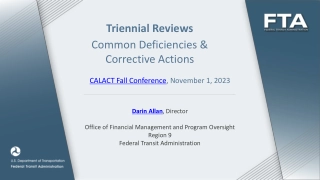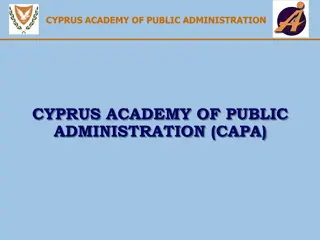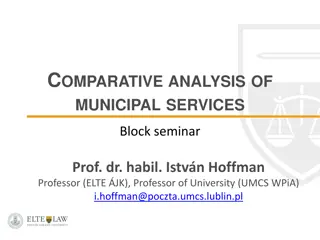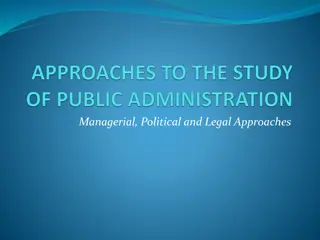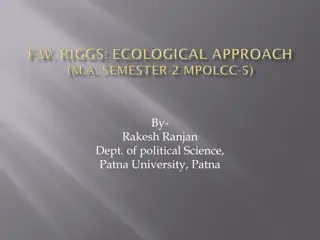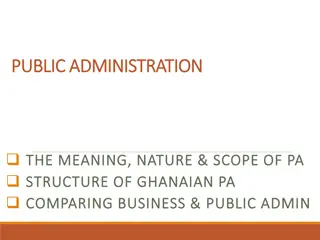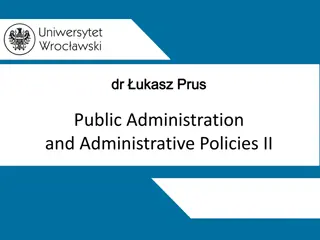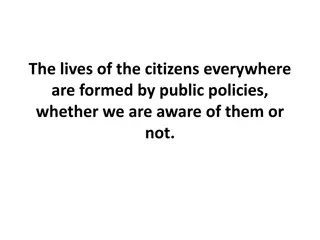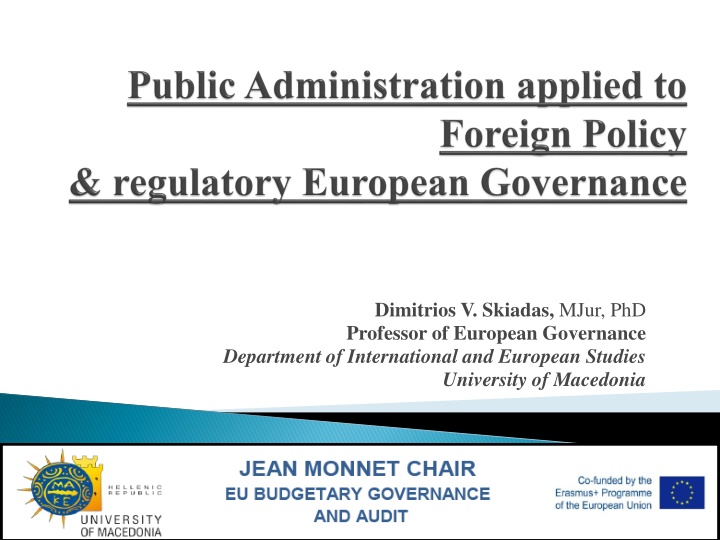
Public Administration: An Overview
Public administration is a multifaceted academic discipline and professional field that analyzes government policies, prepares civil servants, and manages public programs. It encompasses various sub-fields and functions essential for governmental operations, emphasizing human resources, organizational theory, policy analysis, budgeting, ethics, and more. This overview provides insights into the complex nature of public administration, its historical development, and its integral role in state functioning worldwide.
Download Presentation

Please find below an Image/Link to download the presentation.
The content on the website is provided AS IS for your information and personal use only. It may not be sold, licensed, or shared on other websites without obtaining consent from the author. If you encounter any issues during the download, it is possible that the publisher has removed the file from their server.
You are allowed to download the files provided on this website for personal or commercial use, subject to the condition that they are used lawfully. All files are the property of their respective owners.
The content on the website is provided AS IS for your information and personal use only. It may not be sold, licensed, or shared on other websites without obtaining consent from the author.
E N D
Presentation Transcript
Dimitrios V. Skiadas, MJur, PhD Professor of European Governance Department of International and European Studies University of Macedonia
What is Public Administration? Is it a discipline? Profession? Field? Focus? Enterprise? Or, what? Public Administration throughout the world is intricately intertwined with state development, its whole and parts, its past, present and future. Thus, Public Administration can only be understood within the peculiar, nation- state context. In Europe literally the State makes Public Administration In the United States, the reverse can be said to be true: Public Administration makes the State
Public administration is both an academic discipline (ie field of study) and a field of practice (ie occupation); There is much disagreement about whether the study of public administration can properly be called a discipline, largely because of the debate over whether public administration is a subfield of political science or a subfield of administrative science. As a discipline, Public Administration analyses the mechanism to implement government policy and it prepares civil servants for this work; As a field of practice, it entails the management of policies so that government can function;
Public administration has no generally accepted definition, because the scope of the subject is so extended and so debatable that it is easier to explain than define. Some definitions are: The management of public programs" The translation of politics into the reality that citizens see every day" The study of government decision making, the analysis of the policies themselves, the various inputs that have produced them, and the inputs necessary to produce alternative policies According to the North American Industry Classification System, adopted by the USA Government, Public Administration comprises establishments primarily engaged in activities of a governmental nature, that is, the enactment and judicial interpretation of laws and their pursuant regulations, and the administration of programs based on them. This includes legislative activities, taxation, national defence, public order and safety, immigration services, foreign affairs and international assistance, and the administration of government programs, etc. All these are activities purely governmental in nature.
Until the mid-20th century and the dissemination of the German sociologist Max Weber's theory of bureaucracy there was not much interest in a theory of public administration; The field is multidisciplinary in character; Among the various proposals for public administration's sub-fields, six pillars have been identified, including human resources, organizational theory, policy analysis and statistics, budgeting and ethics. In an more academic approach the study of public administration is defined as a program that prepares individuals to serve as managers in the executive arm of local, state, and federal government and that focuses on the systematic study of executive organization and management. It includes: instruction in the roles, development and principles of public administration; the management of public policy; executive-legislative relations; public budgetary processes administrative law; public personnel management; professional ethics and research methods. and financial management;
1. Getting it right Acting in accordance with the law and with regard for the rights of those concerned. Acting in accordance with the PA s policy and guidance (published or internal). Taking proper account of established good practice. Providing effective services, using appropriately trained and competent staff. Taking reasonable decisions, based on all relevant considerations. 2. Being customer focused Ensuring people can access services easily. Informing customers what they can expect and what PAexpects of them. Keeping to its commitments, including any published service standards. Dealing with people helpfully, promptly and sensitively, bearing in mind their individual circumstances. Responding to customers needs flexibly, including, where appropriate, co- ordinating a response with other service providers.
3. Being open and accountable Being open and clear about policies and procedures and ensuring that information, and any advice provided, is clear, accurate and complete. Stating its criteria for decision making and giving reasons for decisions. Handling information properly and appropriately. Keeping proper and appropriate records. Taking responsibility for its actions. 4.Acting fairly and proportionately Treating people impartially, with respect and courtesy. Treating people without unlawful discrimination or prejudice, and ensuring no conflict of interests. Dealing with people and issues objectively and consistently. Ensuring that decisions and actions are proportionate, appropriate and fair.
5. Putting things right Acknowledging mistakes and apologising where appropriate. Putting mistakes right quickly and effectively. Providing clear and timely information on how and when to appeal or complain. Operating an effective complaints procedure, which includes offering a fair and appropriate remedy when a complaint is upheld. 6. Seeking continuous improvement Reviewing policies and procedures regularly to ensure they are effective. Asking for feedback and using it to improve services and performance. Ensuring that the public body learns lessons from complaints and uses these to improve services and performance.
By studying Public Administration, either as an academic or as an practitioner, one may identify a constant evolving process of developing the national, European and international administrative legal orders and administrative practices. And this evolution is characterised by a significant degree of convergence among these factors. There are several driving forces for this, such as economic pressures from individuals and firms, regular and continuous contacts between public officials of Member States and, finally and especially, the jurisprudence of the Courts at national, European and international level. Although constitutions and subsequent legislation convey general law principles and define standards for administrative actions, it is the courts that refine those standards, i.e. define levels of acceptability for public administration practices on a case-by-case basis.
Traditionally, standards of administrative performance have been defined and refined within the national boundaries of sovereign states. They have been the products of national constitutional arrangements, law- making activity of national parliaments, decisions of national administrative authorities and rulings of national courts. In the EU context, as well as the international context, these processes are becoming increasingly supranational, thus formulating shared mandatory administrative standards, that should be adhered to. However, stressing the harmonising potential of public administration standards is not to say that administrative institutions should be homogeneously set up across all states. The important message is that, independently of institutional arrangements, all forms of public administration must recognise principles and adhere to certain common standards.
In some countries the administrative law principles, setting standards and inspiring the behaviour of civil servants, usually appear scattered among different pieces of legislation ranking from the constitution to several acts of Parliament, and specific pieces of delegated legislation as well as case law of the courts dealing with litigation concerning public administration. Other countries have put in force general codification on administrative procedures, which gather and attempt to systematise many of these principles. These administrative principles are not simply ideas based on goodwill; they are embedded in institutions and administrative procedures at all levels. Actors in the public sphere are legally obliged to comply with these legal principles, which must be upheld by independent control bodies, systems of justice and judicial enforcement, parliamentary scrutiny, and by ensuring opportunities for hearing and redress to individuals and legal persons.
Administrative law principles and civil service are at times difficult to define. Frequently they seem to contradict each other in a given situation. (i.e. Efficiency seems to be at odds with due process; professional loyalty to the government seems to oppose professional integrity and political neutrality; discretionary decisions might seem to go against the rule of law, etc) This elusive nature of administrative law principles is one of the reasons why blank concepts are so common in administrative law and civil service regulations. This is also one of the reasons why the courts , at national, European and international level, are so often invoked to solve conflicts and to continually refine these definitions in a doctrinal construction, adapted over time. Perhaps it is useless, and even counterproductive at times, to aim to clearly define the boundaries of administrative law principles. In terms of law-making, when such an attempt has been made, usually in the form of very detailed casuistic distinctions, the end result has frequently been more confusion. Confusion in this domain easily generates injustice.
Exacerbated attempts to ensure detail in regulating such elusive matters tend to result in inconsistency and contradiction. Contradiction and discrepancy also cause difficulties in making these principles actual by adversely affecting law enforcement. From the perspective of law making it is probably considered wise to resort to blank concepts because of their malleability to fit in disparate situations. From the standpoint of civil servants and public authorities behaviour, relying on common sense and seeking inspiration from consolidated case law doctrine would be advisable.
The Public Administration principles have been divided into six categories (OECD/EU SIGMA Initiative): Strategic Framework of Public Administration Reform Policy Development and Co-ordination Public Service and Human Resources Management Accountability Service Delivery Public Financial Management These Principles are not a checklist to be applied mechanically. Public bodies should use their judgment in applying the Principles to produce reasonable, fair and proportionate results in the circumstances.
This administrative context is made up of several factors, the more important of which are: The quality of substantive regulatory law: Regulatory law provides the framework for decision-making within a given policy field (for instance, in urban planning or on environmental issues). In other words, it represents a tool for officials and a source of information and prediction for the public. The quality of procedural administrative law: Procedural administrative law provides due procedures for administrative decision-making, for co-ordination and for balancing powers, for officials relations and communication with the public, and for enabling any interested party to be heard or to appeal. The quality of financial and administrative accountability and control mechanisms: These work for transparency, provide checks for financial and administrative decision-making, and provide means for correction, prosecution and redress.
At the same time, these three factors provide the legal values and principles which contribute decisively to shaping the attitude and behaviour of public managers and the rest of the civil servants operating within that administrative context. These legal principles will be essential as guiding principles for decision- making and behaviour; they will reduce the likelihood of arbitrary decisions by allowing discretionary decision-making within the legal administrative framework. In the end, the principles of administrative law will strongly contribute to laying the foundation of a professional public administration. The professionalisation of the public administration is, therefore, a much wider task than implementing civil service regulations and introducing personnel management improvements. If the administrative context within which officials have to work is not also improved, they might still have to make arbitrary decisions, with insufficient communication with the public, and insufficient co-ordination with other institutions, even if they are in a situation where they have been selected on merit and are exposed to systematic training.
Civil Service Values are Legally Binding Principles : The civil service is bound by the principles enshrined in constitutional arrangements and in administrative law. From this viewpoint, it can be said that civil service values are legal values. Legal values are not the same as ethical values, even if they can broadly overlap. Ethical values are guides for action, and their breaching deserves social reproach. Legal values, when breached, have legal consequences through the civil service law s disciplinary provisions. Civil servants are bound by the administrative principles established in legislation. Civil Servants are not Mere Employees of the State: Civil servants are subject to legal principles and compulsory rules that derive from their specific location within the hierarchical structure of the state. This location shapes a profession, which deals with fundamental rights of their fellow citizens. Civil service regulations do not simply regulate the working relationships between an employer and its employees, as labour law does. Civil service regulations intend, a) to protect civil servants in performing their very special social role in democratic societies and, b) to tighten professional standards by virtue of the delicate issues which civil servants have to deal with. Civil servants are actors within the public sphere of society, the sphere which falls within the domain of public law.
Administrative Law Principles Create Civil Service Behavioural Patterns: Nevertheless, a civil service system regulated by a civil service act is not sufficient to make a public administration professional, efficient, effective, impartial, abiding by the rule of law, and well-performing. It is also necessary to have substantive and procedural administrative legislation of sufficient quality. This legislation will not only provide civil servants with an important tool for performing their duties and for realising the public law principles described above, but also with clear procedures to guide their work and to render their actions and decisions predictable. Additional procedural and substantive legislation is also needed to ensure sufficient internal and external control of public administration and the civil service, particularly in terms of public finance, quality control, procedural supervision, and above all, to ensure an independent, well-functioning judicial system able to effectively redress administrative actions and decisions by means of appeal. This requirement is not only for the sake of the legal certainty and reliability of public administration, but also to ensure the appropriate legal protection of individual rights and legitimate expectations.
In assessing the CFSP and its institutional structures, ones notes two major paradoxes. First: it is a field in which both public and academic perceptions would suggest real limits to European integration. This field of policy is the first and last bastion of national sovereignty . Yet, there are initiatives aiming at formulating and implementing policy options at EU level. Second: CFSP was very deliberately situated under the second Pillar of the EU, according to the Maastricht Treaty, and now, under the Lisbon Treaty, it has been maintained as a policy field in which intergovernmentalism is considered to be sacrosanct and all decisions are officially taken either at Foreign Ministers or at Heads of State or Government level; however, the reality is far more complex as CFSP involves a mix of intergovernmental and supranational procedures ( supra-national inter-governmentalism , see Howorth, 2000). Naturally, there are significant differences between the practices of the respective actors, in terms of the precise location and dynamics of decision-shaping and decision-making. But, there is a very dintinct element of a de facto supranationalism.
Pre-Lisbon Structure of EU Foreign Policy Institutional Framework Source: House of Commons Select Committee on foreign Affairs
Seeing implementation, three original institutional sins have been identified in the relevant system of governance (Vai, 2016): this framework of foreign policy formulation and 1) an artificial separation within the architecture of the CFSP; 2) a lack of EU capabilities; 3) a democratic deficit in the CFSP policy cycles.
First Sin: Artificial Separation - normally, an effective foreign policy is a common effort that brings together a number of different thematic and geographic policies carried out by several institutional actors. In the EU context, there is an essential difference: the foreign policy or the so-called external action appears structurally divided. On the one hand, this policy is carried out through the community policies with an external projection such as development cooperation, humanitarian aid, enlargement and neighbourhood policy, trade, energy, etc. The formulation and implementation of these policies is mainly up to the European Commission, while the relevant decision making procedure involves fully the European Parliament and the Council, on equal basis and acting by majority votes. On the other hand, there is the framework of the Common Foreign and Security Policy (CFPS) that covers all areas of foreign policies (except those run by the Commission), and which also includes an operational civil-military branch, the Common Security and Defence Policy (CSDP). The CFSP/CSDP is the realm of the Council and the Member States, that take decisions by unanimity with limited involvement of the European Parliament, the Commission, and the EU Court of Justice. Therefore, the Union s foreign policy as a whole lives today an institutional artificial separation between the low politics (which entail economic and social questions) run via the community method, and the high politics (which entails life- and-death issues of political order and violence), shaped by advanced and structured intergovernmental cooperation.
Second sin: Lack of capabilities - the resources and the instruments at the disposal of the EU are still not sufficient to reach its goals in the field of foreign policy, despite an improvement of the situation since the middle of the 1990s. Due to the current tightness of the EU budget and the inexistence of a real system of generating its own resources, the financing of the community policies and of the CFSP has not always proved to be adequate. Concerning the instruments, the external action of the Union still largely relies on the Member States capabilities. This is especially true considering the EU ambitions to become a global security provider and looking to what the CSDP is able to offer today: the EU does not have its own intelligence agency, nor a permanent common European military force, while the European costal guard is still in its infancy, trying to sort out problems inherited from its predecessor, FRONTEX. Deficiencies like these represent a clear limit for the implementation of the Union s foreign policy and also cause difficulties to the decision making process. As an example, the CSDP military operations are mainly nationally-funded with direct involvement of national military and civilian personnel. This state of affairs can hardly incentivise the Member States to undertake such initiatives, or alternatively leads them to launch missions inadequate to the given targets.
Third Sin: Democratic deficit in CFSP The low level of democratic participation that still characterises European decision making in a large number of policy areas that certainly includes the the CFSP/CSDP can be considered a direct matter of concern for the expected results of EU external action. Abandoning for a moment the ethical justifications in favour of democracy, from a theoretical point of view the policy effectiveness could also be maximized by an autocratic regime. Nevertheless, in the Union s foreign policy institutional machinery the lack of democracy raises two core issues. Firstly, the limited powers of the European Parliament in the field of foreign policy, and the exclusion of the Commission from the CSFP/CSDP policy cycle have generated a number of negative consequences (ie isolation). Secondly, the question of legitimacy and respect within the EU of the same democratic values and procedures that the Union itself supports and tries to spread outside its borders must be taken into account. A discrepancy between what the EU says outside and what it does inside can became a potential stain on the EU s international and domestic image.
The amendments of the Lisbon Treaty introduced major innovations in the Unions foreign policy governance. They attempted to mitigate the first sin, without however incorporating the CFSP in the supranationalist scheme of the Union (as such an endeavour would have required an answer to the EU s teleological dilemma), offered some solutions for the second one, and made minor adjustments that have not dissipated the democratic deficit in the EFP. All in all, however, the post-Lisbon institutional architecture has not manage to fully overcome the three original sins and they still affect negatively the qualities that the EU should have in order to be effective. In institutional terms, two significant changes were made: 1) the post of the High Representative of the Union for Foreign Affairs and Security Policy (HR), who chairs the Foreign Affairs Council (FAC) and is also vice- president of the Commission (VP); 2) the European External Action Service (EEAS), a diplomatic service composed of European civil servants and national diplomats with a headquarters in Brussels and a network of delegations in third countries and international organisations. Thus, the Lisbon Treaty, by solidifying formal intergovernmentalism in the decision-making process while including supranational dimensions into the CFSP/CSDP, contributed to the complex scheme that was indentified above between the intergovernmentalist and the supranationalist element of the Union.
Post-Lisbon Structure of EU Foreign Policy Institutional Framework Source: House of Commons Select Committee on foreign Affairs
The major, distinctive, elements of the decision making process in matters of common foreign and security policy, as established by the Lisbon Treaty, are the following: a) the right of initiative and the Commission s role, b) the decision making in the Council c) the role of the Parliament is much weaker under CFSP. A. The right of initiative and the Commission s role One of the key rights of the Commission, in the supranationalist scheme of the Union, is the right of initiative. However, in matters of CFSP, both the EU High Representative for Foreign Affairs and Security Policy/Vice President (HR/VP) and EU member states have the right to initiate policy, not the Commission. The Commission is able to initiate a joint-proposal with the High Representative, but not by itself. To this effect, Article 22, para. 1 of the TEU states that Any Member State, the High Representative of the Union for Foreign Affairs and Security Policy, or the High Representative with the Commission s support, may refer any question relating to the common foreign and security policy to the Council and may submit to it, respectively, initiatives or proposals The Commission has a very limited role, entailing the provision of support (for instance documentation) to the initiatives undertaken by the other actors.
Unifying the former Directorate General for External Relations (DG RELEX) of the Commission with the EEAS and, redering the Delegations in other countries to Union s Delegations, and not solely the Commission s, have disrupted the Commission s full association with CFSP. The Service for Foreign Policy Instruments, responsible for the planning and financial administration of the Instrument for Stability remains a Commission service, yet it now reports directly to the HR/VP, not to the Commission as an institution. Concerns about coordination between the EEAS and the Commission have been raised on several occasions, (see for instance in the letter to the HR/VP prepared by 12 Member States on the anniversary of the creation of the EEAS). However, the Commission retains some influence through the High Representative s double role as HR and Vice President of the Commission. Furthermore, it still plays an important role, as it is responsible for drafting the proposal for the EU budget, including the allocations for CFSP. In addition, the European Neighbourhood Policy, development and humanitarian assistance remain in the remit of the Commission with a significant budget (over 7 billion p.a.). An inter-service agreement was signed by the Commission and the EEAS on 13 January 2012, clarifying issues on the balance of power between the Commission and the EEAS. According to the agreement, the Commission and the EEAS jointly plan overall spending strategies on the Union s external relations budget. The funding instruments are jointly programmed (with leading roles for either the Commission or the EEAS depending on the instrument) but implemented solely by the Commission. In addition, the Commission oversees how the HR/VP spends the EEAS annual internal budget.
Therefore, the EU institutional features and the need for expertise must be taken into consideration in order to capture the Commission s influence. The particular institutional structure of the EU combined with the obligation, foreseen by the Treaties, to coordinate external actions across policy areas, creates a demand for services from the Commission. This also allows the Commission to circumvent the inter-governmental policy-making procedures that dominate the CFSP scheme. And once it had access to the de facto decision-making arenas, it convinced both the EEAS and the different Member States of the relevance of its suggestions. This underlines how important it is to go beyond formal characteristics in order to understand the proper operation of such schemes, The Commission s de facto influence illustrates how elements such as informal co- operation, expertise and the ability to present convincing arguments all are factors that may have integrative consequences even in cases where Member States have strong interests. The Commission s actions, behaviour and informal interaction with other actors may be among the factors that help explain the move toward closer co-operation and integration within the CFSP more generally.
The EU does not behave as a classic international organization in the domain but rather that the CFSP is moving beyond inter-governmental co-operation although the Member States remain the key players, policy-making does not lie exclusively in their hands. Both the particular organizational structure of the EU and the Member States requests for expert knowledge in inter-linked policy areas are key to understanding that, in light of the Lisbon Treaty s increased focus on consistency across different policy fields, it is likely that the trend of employing the supranationalist element, as expressed by the Commission, will become stronger. The institutional collocation of the HR/VP, in medio between the Council and the Commission, represents the attempt to reduce the sin of artificial separation noted above, and to ensuring coherence. There are signals of willingness to foster such intra-institutional coherence, like the monthly coordination meetings promoted and chaired by the President of the Commission and the HR/VP that gather the external relations group of commissioners, the participation of the HR/VP in the European Council (agreed with its President) and in the defence, development cooperation, and trade Councils (still chaired by the rotating presidency), etc.
B. Decision-making in the Council Within the EU, the Common Foreign and Security Policy (CFSP) is subject to specific rules and procedures, and it is defined and implemented by the European Council and the Council acting unanimously (Art 24 TEU). The European Council provides the political direction to the EU by identifying the strategic interests, determining the objectives and defining the guidelines of CFSP including for matters with defence implications. The European Council may adopt Council Decisions on common positions and Council Conclusions, which are statements of intent. The configurations of the Council of the EU with competence on CFSP are the Foreign Affairs Council and the General Affairs Council. They consist of the Foreign Affairs ministers of the Member States. The Foreign Affairs Council is chaired by the HR/VP, while the General Affairs Council is chaired by the six-monthly Member States presidencies. They deal with the whole of the Union s external action, including CFSP and CSDP, and are responsible for ensuring consistency across the instruments in the EU s external action. The Political and Security Committee (PSC) is the permanent body constituted by permanent representatives of EU Member States who are based in Brussels and who meet at ambassadorial level (the Member States PSC Ambassadors). It is in charge of monitoring CFSP and CSDP within the Council of the EU and of exercising political control and setting the strategic direction of crisis management operations (Article 38 TEU). The PSC formulates opinions on these issues at the request of the Council, the HR/VP or on its own initiative. The PSC now has a permanent chair directly linked to the Corporate Board of the EEAS. The PSC is assisted by the Military Committee (EUMC) and the Committee for the Civilian Aspects of Crisis Management (CIVCOM).
As for the legal instruments, under the pre-Lisbon regime, CFSP legal instruments could take five forms: a) principles and general guidelines, b) common strategies, c) joint actions, d) common positions or e) decisions. These were (since Lisbon) replaced with one instrument, decisions, that incorporates all of the above and outlines the actions that states are supposed to take. The change in the wording did not cause any change in substance. Decisions on actions are usually the basis of CSDP missions and operations. Decisions on positions may refer to a particular matter of geographic or thematic nature. As before Lisbon, there is no mechanism for the Commission to monitor the implementation of CFSP decisions and the ECJ has no jurisdiction to condemn or imposes any penalties on implementation. member states for non-
Unanimity is the rule for decision making in the area of CFSP. Members of the Council may, however, abstain and make a formal declaration of abstention. The qualified abstention allows them not to apply the decision, which will nevertheless commit the Union. If the abstaining members represent at least one third of the member States comprising at least one third of the population of the Union, the decision shall not be adopted. The Council can act by qualified majority only in the following cases: a)When adopting a decision defining a Union action or position on the basis of a decision of the European Council relating to the Union s strategic interest and objectives; b) When adopting a decision defining a Union action or position, on a proposal presented by the HR/VP following a specific request of the European Council; c) When adopting any decision implementing a decision defining a Union action or position; d) When appointing a Special Representative. The European Council may also unanimously adopt a decision stipulating that the Council shall act by qualified majority in cases other than the ones listed above.
There are further a number of external relations working groups, specialized in thematic or geographic issues, Like the Foreign Affairs Council and the Political and Security Committee, most of these working groups are now chaired on permanent basis by representatives of the EEAS directly appointed by the HR/VP. The presidencies of the working groups are responsible for information sharing from one group to the others. The policy formulation and the decision making belong for the most part to these working groups and preparatory bodies. They prepare the discussions which are then sent to Committee of Permanent Representatives of the Member States governments (COREPER) or to the Political and Security Committee (PSC). The meetings at the Council level where decisions are formally taken are prepared by the HR/VP and the EEAS, that also ensure a constant involvement of the Commission, especially when mixed competence dossiers are under discussion. In this respect, the establishment of the EEAS supports the HR/VP in bridging foreign policies and external policies related competences while maintaining the division of competences mainly unaltered.
The existence of such support structures (committees and working groups), resembling the well-known EU comitology system, is one of the most interesting issues in the decision making process for CFSP. Three points have been identified as crucial in analysing this issue (Tonra, 2011). First, this system reduced the structural differential between CFSP and supranational operations. Although there has not been any substantial integrational shift of policy and/or decision making, there has undeniably been a shift towards standard supranational norms in terms of participation and working method. Second, given that the core player in the EU foreign policy institutional arena is the Council and not the Commission, it is the former which exercises command and control over this policy field. Therefore one wonders on the nature of policy making within this institution classic intergovernmentalism (zero-sum, traded interests and lowest common denominator policy making) or something more and/or different, with supranationalist elements? Third, as a consequence of the preceding two points, there is a sense of developing a Union-centred foreign policy personality. The two key objectives in the historic development of a collective foreign policy voice (alongside effectiveness) have been consistency and coherence. The system of foreign policy working groups represents a compromise between a truly collective (and hence quasi-federal) foreign policy structure (that could have been accommodated within the Commission in the future) and the independent-but-co-operative national foreign policy systems. In case however, such a Union foreign policy would require a different decision making scheme, which does not exist at the moment.
The structure, itself, of the CFSP committees reflect the move from a strict intergovernmentalism towards a Brussels-based working method. The member states remain at the heart of the system, as member state diplomats comprise the core of the policy process. However, in the search for added value (and so as to overcome the intergovernmental dynamic of lowest-common-denominator politics) the member states have sought to develop a new institutional logic for CFSP. The Commission sought to lead the CFSP scheme based on the argument that consistency and coherence in foreign policy cannot be achieved in a bicephalus institutional structure. It has gained only a seat as non-voting member in CFSP configurations, ableit with acknowledged special competences and a unique ability to present an integrated policy perspective to the member states. The Council, through its Secretariat, was the main bureaucratic actor in CFSP, till Lisbon. Its structures allowed, for instance, smaller member states, during their presidencies, to rely upon it for administrative support and the skillful behind-the-scenes negotiations - even in charged atmospheres of crucial debates. However, because the member states are uncomfortable in seeing such a sensitive area as foreign and security policy drawn within the supranationalist scheme of the Union, they have chosen to follow a bureaucratic logic which resembles an adapted intergovernmentalism.
The CFSP working groups reflect this option, as they aim at the formulation of an effective, coherent and consistent European foreign policy. Such an achievement is difficult, using a strict intergovernmentalist approach. Thus, it has been decided to establish intergovernmental structures, assimilating a model of collective policy making that is premised upon intense, highly structured, regular, permanent and ever closer policy consultations. Crucially and distinguishing this level of policy consultation from any other form of diplomatic activity this framework is situated within the institutional structures of an integrative political project. This particular detail makes the entire scheme something other than an intergovernmental bureaucratisation of foreign policy and something more than a Brusselsisation of national foreign policy systems. The workings of such groups have always been, albeit with varying intensity throughout the years, characterised by an informal sense of shared community and fellow-feeling. There is a constant development of a sense of common identity and sense of collective purpose. The informal consultation reflex in which Political Directors sought to accommodate the views of their fellows in almost a personalistic fashion has given way to what might be described as a formal internalisation of shared norms and precedents. This internalisation is in turn being strengthened and developed through its institutionalisation in the working groups structures.
It must be noted that the participants in this process of internalisation are not national civil servants but national diplomats. As a result, the culture of national diplomatic corps may be significant. In all member states, recruitment to the diplomatic corps is distinct from that to the general civil service. While the openness of the diplomatic corps varies from state to state, it is nonetheless an institution of some distinction and set apart from the national civil service. In order to be effective diplomats must also have the capacity to understand and thus to empathise (at least to some degree) with their host government or diplomatic colleagues. It is for this reason that most national diplomatic corps insist that their officials rotate between national and overseas postings. Moreover, in some member states the model diplomats specialised on specific areas or subjects is being rejected in favour of a culture of generalists (diplomats with more general approaches). In sum, diplomats as a category of national officials share a culture and mode of thought which is at least distinct from that of national civil servants and is perhaps more open to the possibilities of shared and mutually beneficial interests. Thus, between the evolving institutional and committee structures of CFSP which have the effect of fostering the internalisation of norms and values and the temperament of the national diplomatic corps, one may see a process of the national interests being transformed within a European context, and of the national foreign policies being Europeanised. In other words, the identity of national foreign policies is changing. This process is certainly most evident among smaller member states but in some larger member states as well. In any event, it certainly registers as being more significant than the actual relocation of decision making bodies to Brussels.
The role of the Parliament in CFSP On addressing the democratic deficit in CFSP, the Lisbon Treaty was not a turning point in the Union s foreign policy field. By maintaining the processes and explicitly forbidding the use of legislative acts in CFSP and preserving the unanimity requirement, the European Parliament s powers remain severely limited in this field, relative to its role as a co-legislator. intergovernmental decision-making The Lisbon Treaty made some concessions with regard to the oversight role of the European Parliament vis- -vis CFSP, by providing it with the right to be consulted regularly on the main aspects and basic choices of CFSP and CSDP. The HR/VP should also ensure that the Parliament s views are taken into consideration. The stronger consultative role is dovetailed with a right of inquiry vis- -vis the Council and an increased number of debates (twice-yearly as opposed to once per year) on progress in implementing CFSP and CSDP. The Parliament can also adopt non-legislative resolutions and recommendations and it issues a yearly report and recommendations on the development of CFSP. In term of actual binding actions, however, the Parliament remains a silent spectator. The Lisbon Treaty states that the Parliament needs to be fully informed at all stages of the procedure during negotiations on international agreements and must give consent to Council decisions concluding international agreements (Art. 218 TEU). Also, a group of parliamentarians representing the major political groups and including the chairs of the Parliament Committee on Foreign Affairs and the Parliament s sub-committee on Security and Defence has the right to access confidential information of the Council.


